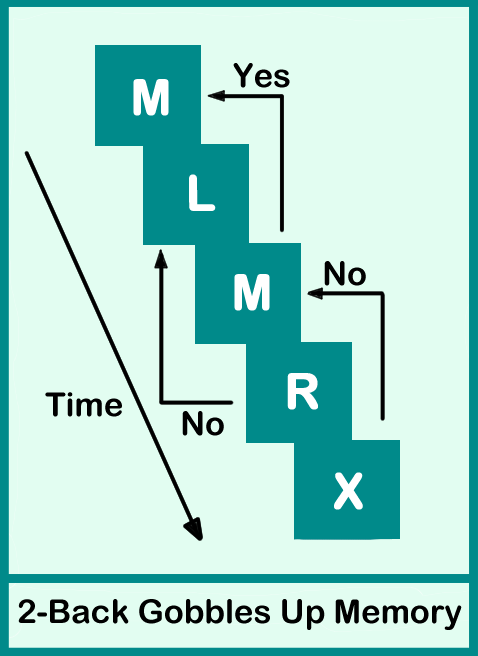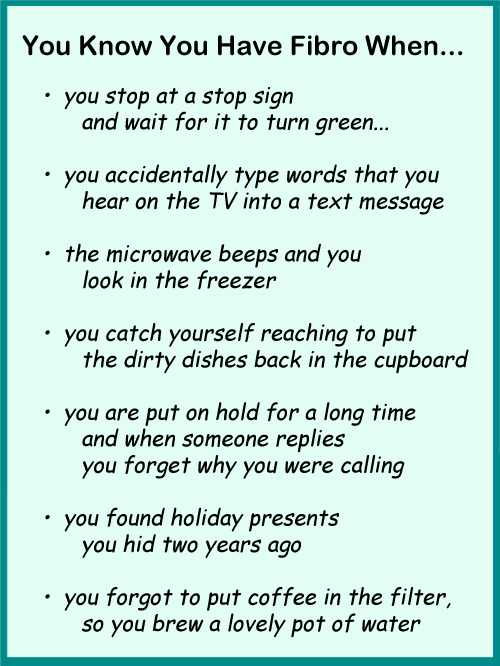Fibromyalgia Basics
FibroFog – An Overwhelmed Brain & How To Treat It

Memory and concentration difficulties, trouble following conversations and word-finding problems are all part of fibrofog. Your brain’s cognitive and memory functions along with your attention span are affected by fibromyalgia. These symptoms are not caused by depression or anxiety, nor are you exaggerating your struggles. Research shows fibromyalgia patients fail to learn information quickly, even when rewarded with free money on an Amazon gift card.
One Thing at a Time
Most activities you do require multitasking. Take walking for example. As you move, you ponder how long it takes to reach your destination and what you plan to do once you get there. Simultaneously moving while thinking is a “dual task.” Your brain must divide its resources between the tasks, and this interferes with function and cognition. Comparing single task (just movement) to dual task highlights cognitive deficits in fibromyalgia.
In one study, fibromyalgia patients were told to remember three words before performing arm curls with a 5-pound weight for 30 seconds.1 Many patients forgot the three words, but not the healthy controls. Why the difference? The healthy group’s brain activity increased during the dual task compared to the single task. But the brains in fibromyalgia patients didn’t jump into higher gear, compromising their cognitive abilities.
Dual tasking also interferes with physical function. Initially, fibromyalgia patients stood on a movable platform that tests balance.2 There was a mirror in front of them so they could adjust their stance accordingly. The test was only 30 seconds long and patients did okay. Yet adding a second task of carrying on a conversation made them sway on the platform … but not the controls.
Defective Pain Control System
The pain inhibitory system reduces the number of pain-related transmissions reaching the brain. It communicates with your brain’s hippocampus and the prefrontal cortex, which are both linked to cognitive function. If your pain inhibitory system is poor, these two brain centers become overwhelmed and this jumbles up your thoughts.
Researchers tested the efficiency of the pain inhibitory system in a group of fibromyalgia patients. They found that less inhibitory capacity corresponds with decreases in attention, memory and executive function.3 The authors write, “Pain is an attention-demanding condition that lowers the brain resources available for cognition in fibromyalgia.” Therefore, treatments that improve pain should also ease fibrofog.
Brain Less Flexible
How flexible is your brain with switching tasks and handling a stream of new information? The 2-Back task is a test designed to determine this.
Participants are given a sequence of 62 letters that appear on a computer screen, one at a time. You must determine if the current letter on the screen is identical to the one that appeared two trials prior in the sequence. In other words, not the last one but the one before it. The test requires constant updating of two letters in working memory.

A group of fibromyalgia patients and healthy controls performed the 2-Back task with electrodes on their scalp to measure brain activity. The patients scored worse than the controls and the electrode data explains why.4 Brain activity needed for encoding new information along with that needed to power working memory were both reduced in people with fibromyalgia.
The cognitive impairments were worse for fibromyalgia patients with higher pain scores. In addition, the study authors say the patients’ performance is “similar to that of older adults.” Yep, brain function is like that of your grandparents.
Attention Deficits
Some studies imply fibrofog is due to selective attention deficits driven by the emotional context of the information. In other words, you are obsessed with pain-related information and you just forget to pay attention to everything else. Fortunately, recent research debunks this outdated theory.
Fibromyalgia patients were subjected to a battery of tests involving a mix of pain-related and neutral cues. At the same time, brain electrical activity was monitored.5 The goal was to determine if the pain-related information captured more attentional resources and compromised reaction times. Regardless of the type of cue, patients required greater cognitive effort to perform the tasks. The authors point to “a nonspecific deficit in sustained attention” in fibromyalgia and this disproves the pain-obsession theory.
Smaller Hippocampus
Your brain’s hippocampus is essential for memory and cognition, and it also helps control stress and pain. In mid-adulthood, the hippocampus starts losing volume. It’s part of aging. But the hippocampus is smaller in fibromyalgia patients compared to age-matched controls. The size reductions also correspond to less dopamine in the area, but what about fibrofog symptoms?
Separating fibromyalgia into two groups (those with and without mild cognitive impairment) helps answer this question. Patients with cognitive impairment had a smaller hippocampus and a longer duration of fibromyalgia symptoms.6 It’s possible that the stress and chronic pain of your disease wears down the hippocampus.
Brain Dopamine
Dopamine is reduced by 30 percent in fibromyalgia patients, particularly in the hippocampus. Yet a neural highway connecting your hippocampus to the prefrontal cortex is crucial for boosting working memory and it relies on dopamine. Strong activation of the prefrontal cortex is also important for shutting down the pain signals that interfere with cognition.
Treatment Strategies
Only a handful of clinical trials attempt to treat fibrofog. So, physicians don’t have the necessary data to confidently address your cognitive difficulties. They can borrow medications used for other conditions, such as attention deficit disorder. Or doctors can target your fibromyalgia pain with activating drugs to free up working memory space and improve alertness. Nondrug approaches are another option.
Nondrug Therapies

Exercise – Moving requires concentration (it’s a dual task). The less fit you are, the more cognitive resources you consume to just navigate across a room. Based on the dual-task findings, one study shows that fibromyalgia patients who regularly exercise perform better on cognitive tests … but the authors admit that fit patients might be less impacted by their fibromyalgia.7 If your insurance covers physical therapy, get help from a PT to improve function and reduce muscle pain.
Reduce Distractions – The brain is a noisy environment and fibromyalgia patients are more bothered by distractions. Most likely, this is due to your sensory sensitivities because you have a brain that magnifies inputs from your surroundings. Stress reduction therapies (including CBT) and meditative movements such as yoga help block out distractions. Quieting your brain improves focus and, hopefully, fibrofog.
Protect Your Brain – Take omega-3 fatty acids (particularly DHA and EPA) to support your brain cells and reduce inflammation. Check supplement labels to ensure the product contains at least 600 mg of DHA plus EPA and do not consume more than 2,000 mg of omega-3 per day. Another supplement, melatonin, works as an antioxidant to protect your brain cells. Take 6 mg at the same time each night.
Cognition Medications
Many medications used to treat fatigue also help fibrofog. Stimulants, modafinil, bupropion, and Savella are the most common and are described in treating fatigue. Most increase dopamine and norepinephrine, and some work on the prefrontal cortex (modafinil).
Memantine blocks the NMDA receptors in your central nervous system, leading to increases in dopamine (primarily in the prefrontal cortex). A clinical trial involving cognitive tests and brain imaging show memantine improves hippocampal function and reduces fibrofog.8 Patients started with 5 mg/day and worked up to 10 to 20 mg/day as tolerated. The most common side effects are headache and dizziness.
Desipramine is an old drug in the tricyclic antidepressant class. It works primarily to increase norepinephrine, while minimally impacting serotonin and histamine. As a result, the drug is less likely to cause daytime sedation (but it may not alleviate pain). Start at the lowest 10 mg dose and work up as needed or tolerated.
Pain relievers come in all forms. Theoretically, medications that treat your pain should boost cognition if the side effects are not sedating.
Cognitive Testing Tools
Curious about how your fibrofog measures up to the patients in the above studies? Or perhaps you want to track treatment efficacy. Here are three frequently used tests:
Montreal Cognitive Assessment (MoCA) – This simple test is used to screen for cognitive impairments and only requires ten minutes to take. But how accurate is it? The MoCA compares reasonably well with a one-hour long battery of tests in fibromyalgia patients.9 The study authors “suggest using the MoCA test in daily clinical practice.” A score of 26 or higher is considered normal. You can take the test on a computer (desktop, laptop or tablet) or download the XPRESSO App for your smartphone.
2-Back – This is a test of your working memory capacity and cognitive flexibility. It’s described in the Brain Less Flexible section above and you can watch a YouTube video demo. If you have a computer (requires keyboard), try taking a short version of the test offered by Psytoolkit.
Stroop Test – How fast can you name a series of colors when the ink appears in a different color (e.g. the word RED appears in yellow ink)? You must name the color, not what the word says. It’s a test of reaction time. A YouTube video demo explains why the Stroop is challenging and takes you through an example test.
Stay Current on Treatments & Research News: Sign up for a Free Membership.
Pain Meds | Fatigue Treatments | Fibro Friendly Exercises | Muscle Pain Relief | Alternative Therapies
References for FibroFog
- Villafaina S, et al. Front Psychol 11:558849, 2020. Free Report
- Villafaina S, et al. BioMed Res Int 5132802, 2019. Free Report
- Serrano PV, et al. Front Behav Neurosci 16:917554, 2022. Free Report
- Mercado F, et al. Pain Med 23(3):475-487. 2022. Free Report
- Cardoso S, et al. BMC Psychol 12(1):104, 2024. Free Report
- Long Y, et al. Front Neurosci 18:1380121, 2024. Free Report
- Villafaina S, et al. Sci Reps 12(1):12616, 2022. Free Report
- Fayed N, et al. Neuroradiol J 32(6):408-419, 2019. Free Report
- Elkana O, et al. Clin Exp Rheum 40:1136-1142, 2022. Free Report
